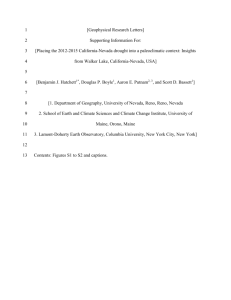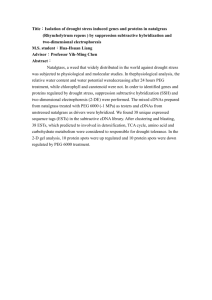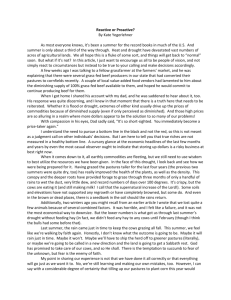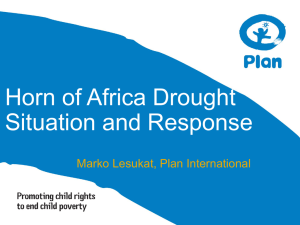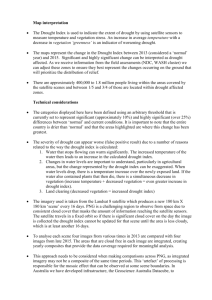International Environmental Modelling and Software Society (iEMSs
advertisement
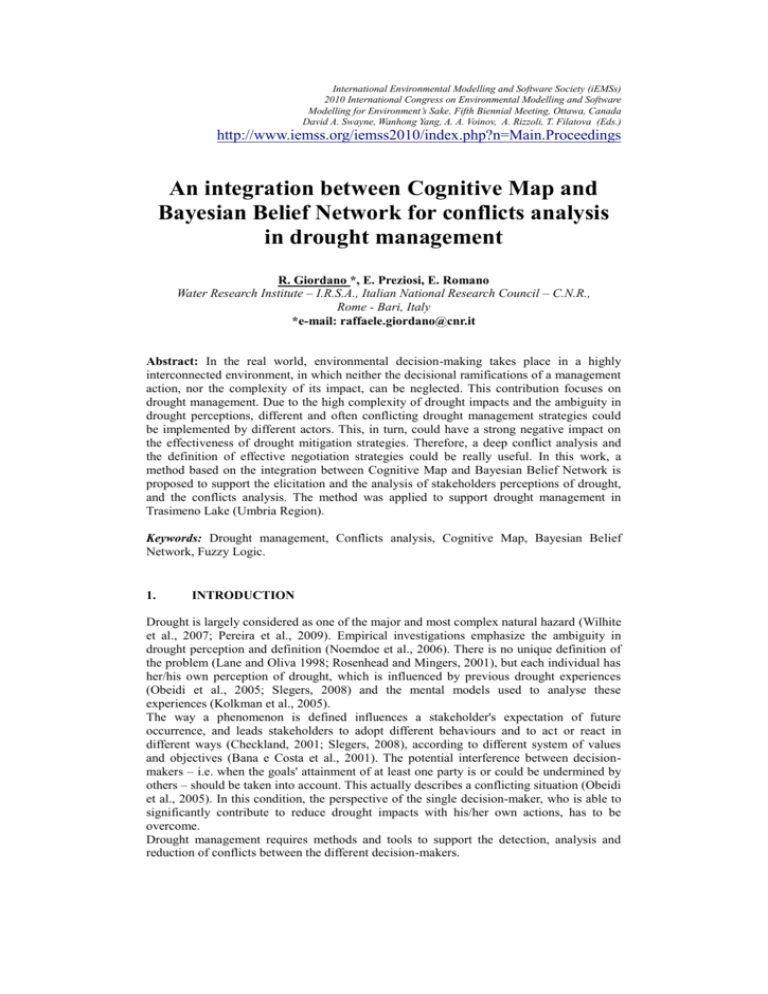
International Environmental Modelling and Software Society (iEMSs)
2010 International Congress on Environmental Modelling and Software
Modelling for Environment’s Sake, Fifth Biennial Meeting, Ottawa, Canada
David A. Swayne, Wanhong Yang, A. A. Voinov, A. Rizzoli, T. Filatova (Eds.)
http://www.iemss.org/iemss2010/index.php?n=Main.Proceedings
An integration between Cognitive Map and
Bayesian Belief Network for conflicts analysis
in drought management
R. Giordano *, E. Preziosi, E. Romano
Water Research Institute – I.R.S.A., Italian National Research Council – C.N.R.,
Rome - Bari, Italy
*e-mail: raffaele.giordano@cnr.it
Abstract: In the real world, environmental decision-making takes place in a highly
interconnected environment, in which neither the decisional ramifications of a management
action, nor the complexity of its impact, can be neglected. This contribution focuses on
drought management. Due to the high complexity of drought impacts and the ambiguity in
drought perceptions, different and often conflicting drought management strategies could
be implemented by different actors. This, in turn, could have a strong negative impact on
the effectiveness of drought mitigation strategies. Therefore, a deep conflict analysis and
the definition of effective negotiation strategies could be really useful. In this work, a
method based on the integration between Cognitive Map and Bayesian Belief Network is
proposed to support the elicitation and the analysis of stakeholders perceptions of drought,
and the conflicts analysis. The method was applied to support drought management in
Trasimeno Lake (Umbria Region).
Keywords: Drought management, Conflicts analysis, Cognitive Map, Bayesian Belief
Network, Fuzzy Logic.
1.
INTRODUCTION
Drought is largely considered as one of the major and most complex natural hazard (Wilhite
et al., 2007; Pereira et al., 2009). Empirical investigations emphasize the ambiguity in
drought perception and definition (Noemdoe et al., 2006). There is no unique definition of
the problem (Lane and Oliva 1998; Rosenhead and Mingers, 2001), but each individual has
her/his own perception of drought, which is influenced by previous drought experiences
(Obeidi et al., 2005; Slegers, 2008) and the mental models used to analyse these
experiences (Kolkman et al., 2005).
The way a phenomenon is defined influences a stakeholder's expectation of future
occurrence, and leads stakeholders to adopt different behaviours and to act or react in
different ways (Checkland, 2001; Slegers, 2008), according to different system of values
and objectives (Bana e Costa et al., 2001). The potential interference between decisionmakers – i.e. when the goals' attainment of at least one party is or could be undermined by
others – should be taken into account. This actually describes a conflicting situation (Obeidi
et al., 2005). In this condition, the perspective of the single decision-maker, who is able to
significantly contribute to reduce drought impacts with his/her own actions, has to be
overcome.
Drought management requires methods and tools to support the detection, analysis and
reduction of conflicts between the different decision-makers.
In this work, an integration between Cognitive Map (CM) and Bayesian Belief Network
(BBN) is proposed to structure stakeholders' perception of drought, and to analyze the
potential conflicts due to interference between the different drought management strategies.
The methodology was experimentally implemented to analyze drought perception in Lake
Trasimeno, situated in the Umbria region (Central Italy).
2.
CONFLICT ANALYSIS AND REDUCTION: AN INTRODUCTION TO
THE LITERATURE REVIEW.
One challenge facing researchers and practitioners in negotiation and conflicts resolution is
the detection of conflicts (Obeidi et al., 2005). Conflicts is driven by the perceived
incompatibility of something of relevance, at least for one party. This thing could be
different goals, interests, belief. The more substantive this thing is to individual the more
complex and ingrained the conflict becomes, and the harder is to resolve (Obeidi et al.,
2005; Obeidi et al., 2009).
Many methods have been developed to analyze conflicts. All these methods treats conflict
as an interactive decision problem between two or more decision-makers, with their own
systems of values and objectives (Bana e Costa, 2001; Obeidi et al., 2005; Obeidi et al.,
2009). Conflict is a process triggered by an event or stimulus and evolving through a series
of sequential stages (Obeidi et al., 2009).
Most of conflict resolution approaches and methods are process-oriented, trying to
minimize the disagreement on the outcomes of the negotiation process by managing during
it all the sources of potential inter-actors conflict (Susskind and Cruikshank, 1987). The
process of conflict resolution aims to support the debate among the different decisionmakers, in order to make their opinions as close as possible (Herrera et al., 1996). Many
authors suggested to use a measure of conflict to support the debate and to assess the
effectiveness of the negotiation process (Herrera et al., 2001; Fedrizzi et al., 1999;
Giordano et al., 2007).
Other approaches are outcome-oriented rather process-oriented. These approaches, also
called pre-negotiation, aim to dissolve the conflict in an enlarged frame rather than try to
resolve it within the set of existing alternatives (Bana e Costa et al., 2001). This approach is
based on the invention of a new solution that would reconcile as much as possible the main
sources of conflict a priori detected. This new solution is also called the prominent
alternative, whose absence is the main cause of the conflict (Zeleny, 2008). These
approaches assume that a conflict resolution via compromise is only a temporary solution.
Sooner or later the suppressed perceptions and values will allow the conflict to re-emerge.
The only way to reduce the intensity of conflict is to generate alternatives that are closer to
the prominent alternative (Zeleny, 2008).
The first step to support the creative process to invent or discovery the prominent
alternative is to address a fundamental question “where does the conflict lay?” (Bana e
Costa et al., 2001), that is, to detect the main reasons behind the conflicts.
The aim of this work is to develop and test a methodology able to investigate the
differences between stakeholders' drought perceptions, to identify and analyse the conflict
and, thus, to support the identification of the prominent solution for drought management.
3.
DESCRIPTION OF THE CASE STUDY
The methodology developed was applied to elicit and analyse drought perceptions in the
area of Lake Trasimeno, located in the Umbria region (Central Italy).
The Trasimeno Lake covers a surface area of 128 km2. The lake has unusual
hydromorphological conditions, characterized by the absence of substantial inlet and outlet
rivers. The tributary catchment of the lake covers a limited area. Moreover, the depth of the
lake is around 4 m, with a maximum of 6 m. These conditions make the lake particularly
vulnerable to drought phenomena.
Drought increases the effects of already adverse climatic conditions. Drought is quite
recursive in this area. The last strong drought phenomenon initiated in 2002 and finished in
2006. During this period, the drought had a strong negative impact on the local socio –
economic conditions. In fact, most of the economic activities were strongly influenced by
the state of the lake. Farmers used to withdraw water for irrigation directly from the lake.
Therefore, the reduction of the level significantly decreased the water available for
irrigation. Moreover, the reduction in the level of the lake had a strong negative impact on
the tourist industry in the area.
The stakeholders analysis allowed the authors to identify the main actors to be involved in
this study: 1) the Umbria Regional Authority; 2) the Local Irrigation System Management
(EIUT); 3) the local Municipalities; 4) the Local Development Support Association (GAL);
5) the local Farmers Association; 6) the Regional Environmental Protection Authority
(ARPA); 7) the local Tourist Industry Association.
4.
CONFLICT ANALYSIS FOR DROUGHT MANAGEMENT
A methodology based on the integration between Cognitive Map (CM) and Bayesian Belief
Network (BBN) was developed to structure drought perceptions and to analyse conflicts.
For a detailed description of the CM methodology, a reader could refer to (Axelrod, 1976;
Eden, 2004; Eden and Ackerman, 2001; Marchant, 1999; Montibeller et al., 2001).
Interesting experiences concerning the implementation of BBN to support environmental
management could be found in (Bromley et al., 2005; Castelletti and Soncini-Sessa, 2007;
Henriksen and Barlebo, 2008)
A significant strength of CM is that the modelling is closed to natural language. CM
captures causal knowledge of stakeholders in a more comprehensive and less-time
consuming manner than other methods (Nadkarni and Shenoy, 2004), and the results are
easily comprehensible for participants. Nevertheless, CM permit only limited forms of
causal inference, and they are not able to take into account the uncertainty due to limited
knowledge of the system.
BBN showed great potentialities to deal with uncertainty caused by imperfect knowledge of
the state of the domains and partial understanding of the mechanisms governing the
behaviour of the domains (Bromley et al., 2005). This makes BBN suited to structure the
stakeholders' understandings of the drought phenomenon and its impacts on the system, and
to define the mental models influencing their behaviours to cope with drought.
The potentialities of CM and BBN integration and the main issues to be addressed are
described in (Nadkarni and Shenoy, 2004).
The main steps of the methodology are: elicitation of stakeholders' mental models
concerning drought perceptions (knowledge collection; development of CM;development
of BBN from CM); conflicts analysis.
4.1.
Elicitation of drought perception
A round of semi-structured interviews was carried out involving the main stakeholders.
Following Slegers (2008), the interviews were aimed at collecting stakeholders' experiences
about both direct and indirect drought impacts. Moreover, the stakeholders were required to
specify elements which can either increase or decrease the impacts of a drought.
The collected narratives were analysed and coded in CM. To this aim, causal statements
were identified (Nadkarni and Shenoy, 2004). The causal statements were transformed in
causal links in the CM. Using the results of the interviews, a polarity and a weight were
assigned to each link (Marchant, 1999). The weight of each link was described using
linguistic statements, i.e. “high”, “medium”, “low”.
Figure 1 shows the CM developed using the interview to farmers association.
Figure 1: CM obtained analysing the results of farmers' association interview. The links are
represented with different thickness according to strength of the relationships. The “-” is
used for the negative links.
CM analysis supported the identification of the most important elements in drought
perceptions for each stakeholder. The importance degree was assessed considering their
centrality in the CM. The weighted extended domain analysis was applied (Eden, 2004).
Drought perception depends on the severity of drought impacts. Therefore the analysis of
drought perceptions was completed by assessing and comparing the impacts of drought on
the elements in the stakeholders' mental models. To this aim, BBN were derived starting
from the CM. To construct the BBN starting from the CM requires the definition of the
state space of each variable and the derivation of the conditional probabilities associated
with the variables in the map. In our work, the definition of the state space were carried out
interacting with stakeholders. The conditional probabilities associated with the variables
were derived using the weight and the polarity of the links in the CM.
At the end of this step the BBNs representing the stakeholders' understanding of the
drought phenomenon were derived. The BBNs were used to assess the main drought
impacts according to stakeholders' mental models. The comparison between the values in
rainy conditions and during a drought period allowed us to assess the drought impacts
(figure 2 a and b).
Figure 2a: Farmers' association BBN in rainy conditions. Figure 2b: Farmers' association
BBN in drought conditions.
Figure 3 shows the comparison between the values of the variable “Water balance”. The
change between the two states was calculated as distance between the centroids of the two
graphs.
0,9
0,8
Drought condition
0,7
0,6
0,5
Negative
Positive
0,4
X'C=0.70
0,3
0,2
0,1
0
0,8
0,7
Rainy condition
0,6
0,5
Negative
Positive
0,4
XC=1.23
0,3
0,2
0,1
0
Figure 3: Comparison between the value of “Water balance” during a drought phenomenon
and in a rainy period. XC and X'C represent the centroids of the two graphs.
The change was assessed according to the following formula:
C=X'C – XC
[1]
Therefore, C = -0,53. In order to simulate the approximate reasoning of the stakeholders, a
fuzzy linguistic function was defined to describe the impact degree (figure 4).
μ
Strongly
negative
Moderately
negative
Negative Positive Moderately
positive
Strongly
positive
0,80
-0,53
Cn
-0,7
-0,6 -0,40 -0,3
0,3
0,40 0,6
0,7
Cp
Figure 4: Fuzzy function to describe the degree of change due to drought initiation. The
distance between the centroids was reported on the x-axis.
where Cn represents negative changes due to drought. A negative change can occur either
when a negative element (e.g. price of water) increases or when a positive element (e.g.
farmers income) decreases. Cp represents positive impacts. μ represents the membership
degree to the fuzzy sets “Strongly Negative”, “Moderately negative”, “Negative”,
“Positive”, “Moderately positive”, “Strongly positive”.
C was reported as crisp value on the x-axis. Thus, the drought had a “moderately negative”
impact on “water balance”, with a membership equal to 0.80.
The same calculation was done for the other elements in farmers' BBN. The aggregation of
the importance degree and the impact degree allowed us to derive the influence of each
variable on drought perception. The fuzzy AND operator (Zimmermann, 1991) was adopted
as aggregation operator. The following table summarizes the results of the analysis for the
farmers' BBN.
Tab.1: the main elements influencing the drought perception.
Variables
Importance degree
Impact degree
Influence on drought
perception
Farmers Income
Highly important
Strongly negative
Highly impacting
Water balance
Highly important
Moderately negative
Moderately impacting
Water availability
Highly important
Moderately Negative
Moderately impacting
Quality of production
Highly important
Strongly negative
Highly impacting
Price of water
Important
Negative
Impacting
Lake deficit
Important
Strongly negative
Impacting
Therefore, farmers' perception of drought was influenced mostly by the income, the water
balance, the water availability and the quality of production.
The same analysis was carried out for the other stakeholders' BBN. The results of this
analysis were used as basis for the conflicts analysis in drought management, as described
in the following section.
4.2.
Conflict analysis
The only way to dissolve conflict is to cope with it in creative way, increasing the set of
possible alternatives in order to identify the prominent solution (Zeleny, 2008; Bana e Costa
et al., 2001). To support this creative approach to conflict dissolution, the identification of
the main causes of conflict is crucial.
To this aim, the impacts of the current drought management strategies on the stakeholders
objectives were analysed. Table 2 summarizes the current strategies to cope with drought
and the actors involved.
Tab.2: Actions to cope with drought
Actors
Action to cope with drought
Umbria Regional Authority
1.
2.
To reduce the amount of water exploitable from the lake
To stop the withdraw from the lake
Local Irrigation System
Management
1.
2.
To reduce the amount of water available for irrigation;
To increase the price of water for irrigation (price threshold).
The impacts of these actions on the values systems of the different stakeholders were
simulated using the BBNs. For seek of brevity this contribution is focused on farmers'
drought perception. This is justified further in the text. Figure 5 shows the impacts on
farmers' BBN.
Due to the implementation of the drought management strategies, the state of the variables
“Price threshold” “Water released from consortium” and “Lake regulation” were changed.
Moreover, farmers are forced to reduce the water demand by reducing the irrigated areas
and the cultivated areas (figure 5).
Figure 5: State of the variables of the farmers' BBN due to the implementation of other
stakeholders' strategy.
The impacts of the drought management strategies on farmers was assessed by comparing
the states of the main variables in farmers' BBN. Figure 6 shows the comparison
concerning the value of the variable “water balance”.
0,45
0,4
0,35
0,3
Low
Medium
High
0,25
0,2
0,15
Without drought strategies
XC=1,51
0,1
0,05
0
1,2
1
With drought strategies
0,8
Low
Medium
High
0,6
XC=0.51
0,4
0,2
0
Figure 6: Comparison
between the value of “farmers' income”.
According to [1], C = - 1. Therefore the impact of drought management strategies on water
balance was strongly negative. The degree of impact was calculated for each of the most
important elements in farmers' drought perception. The overall impact was assessed by
aggregating the impacts. The Linear Geometric Weighted Averaging operator (LGWA)
(Xu 2004) was used for the aggregation. This operator made it possible to aggregate
linguistic values for elements that are not equally important and, thus, were characterised
by different weights (Herrera et al. 2001). In this work, the weights were defined
considering the influence on stakeholders' drought perceptions (tab.1). Before applying the
LGWA operator, the weights were modified to comply with the rule Σω i = 1. As reported in
Xu (2004), the term set should be structured in such a way that S i ≥Sj if i ≥j. In this work,
the term set was S = {S1 = Strongly positive impact, S2 = Moderately positive impact, S3 =
Positive impact, S4 = Negative impact; S5 = Moderately negative impact; S6 = Strongly
negative impact}.
The aggregated value is assessed according to the following formula (Xu 2004):
LGWA= S 1 ⊗...⊗ S n
1
n
= S 1 ⊗...⊗ S n
[2]
The impacts of irrigation system management strategy on the main variables of farmer's
BBN are reported in table 3.
1
1
Tab.3: impacts of drought management strategy on farmers' BBN variables
Variables
Impact
Weight ( Σωi = 1)
Farmers Income
Strongly negative
0,2
Water balance
Moderately negative
0,21
Water availability
Strongly negative
0,15
Quality of production
Strongly negative
0,22
Price of water
Negative
0,11
Lake deficit
Moderately negative
0,11
According to [2], LGWA = S5,37. Taking into account the definition of the vector S, the
drought management strategy had a negative impact on farmers' drought perception.
Considering that the more negative the impact the stronger the conflict, there was a strong
conflict between farmers and irrigation system managers. This table allows to identify the
main reasons of the strong conflict between farmers and the two actors devoted to drought
management. The usefulness of this information is discussed in the next session.
The same analysis was carried out with the other stakeholders. The results are not discussed
here since the assessed degree of conflict was rather low.
5. DISCUSSION AND CONCLUSIONS
The adopted approach was discussed with the involved stakeholders in order to identify
benefits and weaknesses.
One of the positive results of the adopted methodology is its ability to make explicit the
differences in drought perceptions. The results of the CM and BBN analysis about the
influences on perceptions were discussed with the involved stakeholders. Thus, they
became aware about the interests and concerns of the other participants about drought
impacts and drought management. This information allowed them to reflect about
divergences and similarities of problem perceptions. E.g. regional authority became aware
that tourist operators and GAL perceived farmers as the main responsible of the lake
quality.
From the decision makers point of view, the main benefits are related to the capability to
simulate the impacts of drought management strategies on stakeholders' objectives and to
identify the main reasons of conflicts. This information can be used by them to increase the
set of potential alternatives in order to define actions as close as possible to the prominent
ones. During the experimentation, the results of conflict analysis were discussed with
decision-makers. Once they became aware of the main farmers' concerns, they started to
discuss about the possibility to make the irrigation system independent from the lake level.
In the meantime, a more effective drought early warning system was proposed, in order to
support farmers in the selection of the most suitable crops according to the foreseen
climatic conditions.
One of the drawbacks highlighted during the analysis of the results concerns the qualitative
nature of the results of BBN simulation. This represented a weakness of the system
according to the decision-makers, who are familiar with quantitative assessments. Thus, for
the decision-makers, qualitative results were considered as not completely reliable. An
important improvement in the system could be made by coupling the BBN with some
quantitative models in order to increase the reliability of the results for the decision-makers.
Acknowledgement
The research activities described in this work have been financially supported by the Italian
Ministry of University and Research (MIUR), National Relevance Research Program 2007
(PRIN 2007) – Drought management and climatic variability (20075WFE7P).
References
Axelrod, R., Structure of Decision - The Cognitive Maps of Political Elites. Princeton
University Press, Princeton, NJ, 1976.
Bana e Costa, C., F. Nunes da Silva and J.C. Vansnick, Conflict dissolution in the public
sector: A case-study, European Journal of Operational researcher, 130, 388-401, 2001.
Bromley, J., N.A. Jackson. O.J. Clymer, A.M. Giacomello, F.V. Jensen, The use of Hugin®
to develop Bayesian networks as an aid to integrated water resources planning.,
Environmnetal Modelling and Software, 20, 231-242, 2005.
Castelletti, A. and R. Soncini-Sessa, Bayesian Networks and participatory modelling in
water resources management, Environmnetal Modelling and Software, 22, 1075-1088,
2007.
Checkland, P., Soft System Methodology. In Rosenhead, J., Mingers J. (eds), Rational
Analysis for a Problematic World. John Wiley and Sons, Chichester, UK, 2001.
Eden, C., Analyzing cognitive maps to help structure issues and problems, European
Journal of Operational Research, 159, 673-686, 2004.
Eden, C. and F. Ackermann, SODA – The principles. In Rosenhead, J., Mingers J. (eds).
Rational Analysis for a Problematic World. John Wiley and Sons, Chichester, UK, 2001.
Fedrizzi, M., M. Fedrizzi, and R.A. Marques Pererira, Soft Consensus and Network
Dynamics in Group Decision Making, International Journal of Intelligent Systems, 14, 6377, 1999.
Giordano, R., G. Passarella, V. Uricchio and M. Vurro, Integrating conflict analysis and
consensus reaching in a decision support system for water resources management, Journal
of Environmental Management, 84, 213-228, 2007.
Henriksen, H.J and H.C. Barlebo, Reflections on the use of Bayesian belief networks for
adaptive management, Journal of Environmental Management, 88, 1025-1036, 2008.
Herrera, F., E. Herrera-Viedma, and F. Chiclana, Multiperson decisionmaking based on
multiplicative preference relations, European Journal of Operational Research, 129, 372–
385, 2001.
Kolkman, M.J., M. Kok, and A. van der Veen, Mental model mapping as a new tool to
analyse the use of information in decision-making in integrated water management, Physics
and Chemistry of the Earth, 30 (4-5), 317-332, 2005.
Lane, D.C., and R. Oliva, The greater whole: Towards a synthesis of system dynamics and
soft system methodology, European Journal of Operational Research, 107, 214-235, 1998.
Marchant, T., Cognitive maps and fuzzy implications, European Journal of Operational
Research, 114, 626-637, 1999.
Montibeller, G., F. Ackermann, V. Belton, and L. Ensslin , Reasoning Maps for Decision
Aid: A Method to Help Integrated Problem Structuring and Exploring of Decision
Alternatives. ORP3, Paris, September 26-29, 2001.
Nadkarni, S. and P.P. Shenoy, A causal mapping approach to constructing Bayesian
networks, Decision Support System, 38, 259-281, 2004.
Noemdoe, S., L. Jonker, and L.A. Swatuk, Perceptions of water scarcity: The case of
Genadendal and outstations, Physics and Chemistry of the Earth, 31, 771 – 778, 2006.
Obeidi, A., K.W. Hipel and D.M. Kilgour, The Role of Emotions in Envisioning Outcomes
in Conflicts Analysis, Group Decision and negotiation, 14, 481-500, 2005.
Obeidi, A., K.W. Hipel and D.M. Kilgour, Perceptual Graph Model Systems, Group
Decision and negotiation, 18, 261-277, 2009.
Pereira, L.S., I. Cordery, and I. Iacovides, Copying with water scarcity. Springer Science +
Business Media, 2009.
Rosenhead, J., and J. Mingers, A New Paradigm for Analysis. In Rosenhead, J., Mingers J.
(eds), Rational Analysis for a Problematic World. John Wiley and Sons, Chichester, UK,
2001.
Slegers, M.F.W., “If only it would rain’’: Farmers’ perceptions of rainfall and drought in
semi-arid central Tanzania, Journal of Arid Environments, 72, 2106 – 2123, 2008.
Susskind, L., Cruikshank, J., Breaking the Impasse – Consensual Approaches to Resolving
Public Disputes, Basic Books, New York, 1987.
Wilhite D. A., M.D. Svoboda , M.J. Hayes, Understanding the complex impacts of drought:
A key to enhancing drought mitigation and preparedness, Water Resources Management,
21, 763-767, 2007.
Xu, Z., A method based on linguistic aggregation operators for group decision making with
linguistic preference relations, Information Sciences, 166, 19–30, 2004.
Zeleny, M., The KM-MCDM interface in decision design: tradeoffs-free conflict
dissolution, International Journal of Applied Decision Sciences, 1(1), 3 – 23, 2008.
Zimmermann, H.J., Fuzzy Sets, Decision Making, and Expert Systems. Kluwer Academic
Publisher, Dordrecht, 1987.
